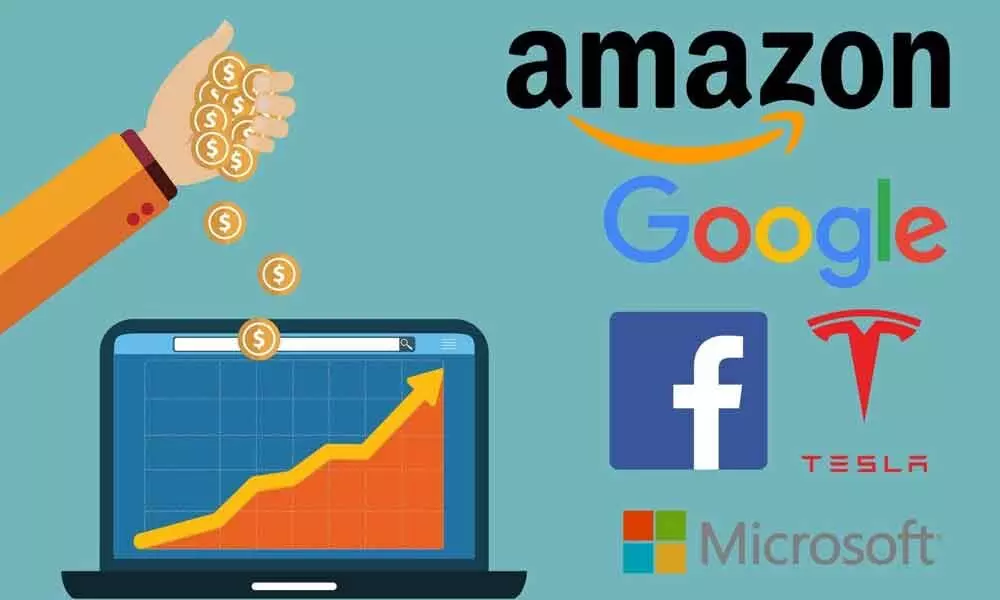Live
- They always want me to win, and now I feel lucky to have been offered a story like ‘Zebra’: Satyadev Kancharana
- ‘Democracy first, humanity first’: PM Modi in Guyana's parliament on two countries' similarities
- PKL Season 11: Telugu Titans register third straight win to top standings
- Is Pollution Contributing to Your COPD?
- NASA Unveils Underwater Robots for Exploring Jupiter's Moons
- Additional Central forces arrive in violence-hit Manipur
- AR Rahman and Saira Banu’s Divorce: Legal Insights into Common Issues in Bollywood Marriages
- 82.7 pc work completed in HPCL Rajasthan Refinery area: official
- Curfew relaxation extended in 5 Manipur districts on Friday
- Tab scam prompts Bengal govt to adopt caution over fund disbursement
Just In

How to buy international stocks?
Some of the consumable goods on a daily basis could turn out to be good investment choices, here’s how you can invest in them
In our daily lives, we consume or get interacted with multiple brands i.e., various companies which provide us with choices in our usage of goods and services. When we use a particular product, the origin could be from India (manufactured) but the brand could be owned by a foreign company whose listing mayn't be wholly or subsidiary is not in India. The pandemic has transformed the way we work, and the enabler of this change is the penetration or adoption of the technology.
As an investor, one of the rudimentary observations in fundamental analysis is to evaluate a company on the basis of the market size and market share of a company's product/service. At this stretch, some of these which we consume on a daily basis could turn out to be good investment choices, only if we could get a hand on them.
As the producers or owners of these products or services are unlisted in our country, access to this is difficult. Of course, the government has allowed Indians under the Liberalized Remittance Scheme (LRS), any resident to remit up to $250,000 in a financial year. This could be done in any number of times in a year though no further remittance is allowed even if the remitted amount is brought back in the same year. So, an Indian investor could use this option to invest in the international stocks which own these brands. For this one has to avail the services of the brokers who provide these facilities and the various costs and taxes associated with it. This, of course is, apart from the enormous amount of exercise to be done to identify a particular stock(s) and also arrive at the right allocation to be done.
The other easier way is to achieve this through global or international funds provided by the mutual funds.
For Indians exploring through mutual funds, there're variety of options to consider from investing through cherry picking active management on one extreme to ETFs (Exchange Traded Funds) on the other with multiple alternatives in between. There are some feeder funds which route the capital invested into an already existing fund operating overseas. Then there're funds which invest specifically into a particular region or sector to cater out viz., DSP Mining Fund or DSP World Agriculture Fund which as the name suggests concentrates purely with this bias of investing philosophy.
Invesco India Feeder - Invesco Global Equity Income Fund which invests the capital collected in India into their global fund, contrast to that is ICICI Prudential US Bluechip Equity Fund, an active management fund which diverts the capital into specific US stocks picks deemed desired by the fund manager. Then there's an offering from Motilal Oswal S&P Index Fund which parks money in the S&P 500 Index of the US directly. A recent offering from Kotak has added a different flavour through their international REIT FoF which predominantly invests in securities of underlying asset as real estate.
The offerings are getting interesting with exploring multiple possibilities like that of investing in sustainable energy through funds like DSP NRNE (Natural Resources and New Energy) fund. Investors are spoilt with choice with offerings like PGIM India Emerging Markets Equity Fund to Edelweiss ASEAN Equity Off Shore Fund. The greatest importance, however, an investor has to consider while opting any of these funds is the fund objective (philosophy, style and scope of investment) and the cost of funds i.e., fund management charges. The latter is lower in the Index funds while higher in the actively managed funds.
The biggest headwinds these funds face is the volatility associated with the currency. Though, traditionally, INR experiences deprecation over long periods (being a net importer), there're bouts of underperformance (in these funds) due to intermittent currency appreciation. Another important aspect that influences the fund performance is the not limited to the geo-political situations but also the factors related to that particular country (regulations, govt. policies, stability, etc.). These funds (irrespective of the underlying asset) are taxed as capital gains based on non-equity. Investors should be judicious in the allocation into these funds and the decision especially shouldn't arise from the past performance while also ensuring enough hedge is provided for these.
(The author is a co-founder of "Wealocity", a wealth management firm and could be reached at [email protected])

© 2024 Hyderabad Media House Limited/The Hans India. All rights reserved. Powered by hocalwire.com







